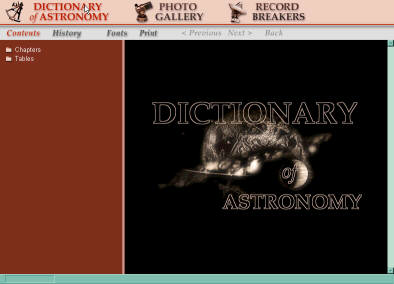
| DAS Home |
RedShift is a product of Maris Multimedia distributed by Focus Multimedia.
It runs on a Windows system. Windows 95, 98 and 2000 are recommended but it also runs on NT 4. You need at least a Pentium processor running at 200 MHz with 64 megabytes of RAM, 2 megabytes of video RAM, 80 megabytes of hard disk space, an 800 x 600 (16-bit) display and a 4x CD-ROM drive. For best performance, upgrade the processor to a Pentium II 350 MHz and increase RAM to 128 megabytes, video RAM to 4 megabytes, display resolution to 1024 x 768 and hard disk space to 300 megabytes.

RedShift 4 comes on two CDs. The first appears to contain most of the software while the second has extended star catalogues. These catalogues feature the HIPPARCOS satellite catalogue (118,000 stars) which must be the most accurate and reliable star catalogue available. It also has the Tycho-2 catalogue which enhances HIPPARCOS using 143 ground-based catalogues to process the HIPPARCOS data. Hence 2,529,913 stars are available to RedShift 4 giving superb finding charts for those tricky objects like the outer planets and faint deep sky objects. Especially since there are half a million stars in the catalogue at the faintest magnitude limit below 12th magnitude. In addition to these two, the program also accesses the 4M and Hubble Guide Star catalogues, the New General Catalogue of Variable Stars and the Washington Double Star Catalogue.
RedShift doesn't just show the stars. It also uses the PGC (Principal Galaxies Catalogue) containing 73,197 galaxies and has a complete model of the solar system. You can simulate the sky from any planet in our system, not just Earth, or fly through the system like an interplanetary probe. The planetary positions are calculated by the Bureau des Longitudes method VSOP87. Over 2000 years into the past or future, the positions are correct to better than 0.1 arcsec. For the inner planets this is better than 0.01 arcsec for 4000 years into the past or future. Since Pluto is not included in VSOP87, a Keplerian orbit is used which is based on an alternative model which covers 1885 to 2099 AD. 15,000 asteroid orbits and 1,700 comets are also in the database.

The utility of RedShift as an astronomical tool has always been augmented by useful reference material. Version 4 has Jacqueline Mitton's Dictionary of Astronomy, a Photo Gallery full of astronomical images (so you can check that you really have found the right fuzzy blob) and a database of astronomical record breakers (good browsing for a cloudy night). The whole can present itself through animated astronomy lectures that are of very good quality. The quality of the maps and images that can be produced by RedShift 4 are also excellent, especially since it contains detailed surface maps of the terrestrial planets and the Moon as well as simpler maps for the other planets and moons. You can also record movies of events simulated by the program for use in your own lectures.

The whole system has been robust during testing and certainly delivers the promised sky maps. Our president is looking forward to using it for public lectures and planning observing sessions and just having fun observing the universe from different perspectives.